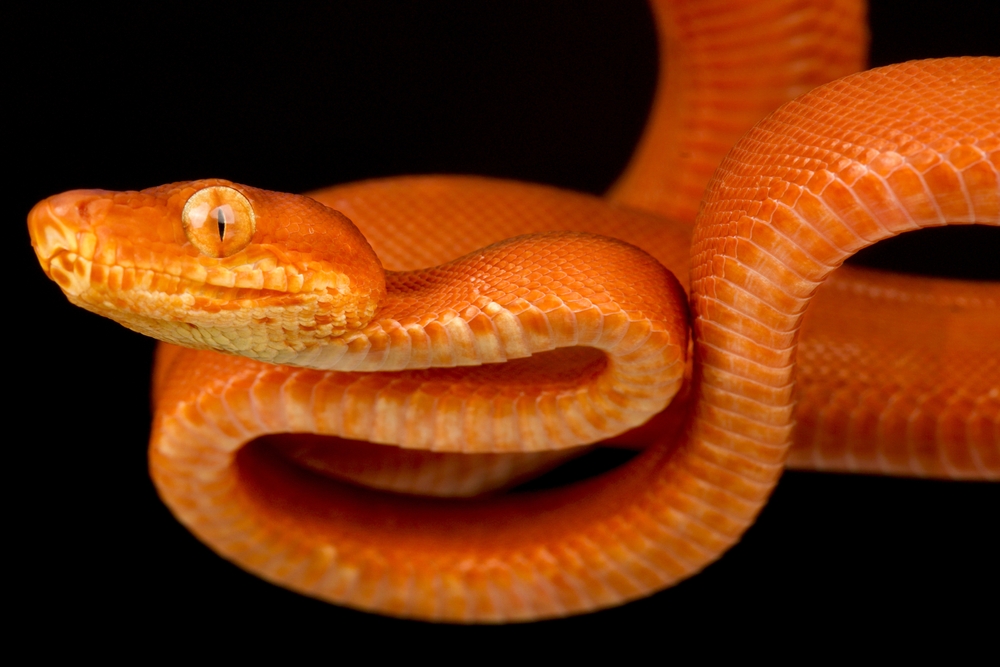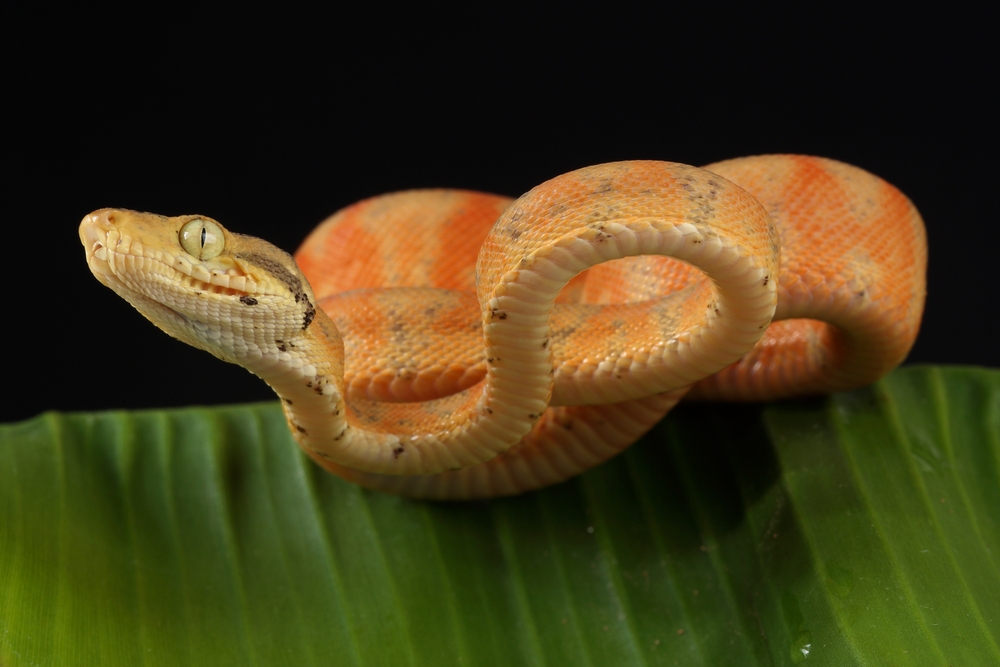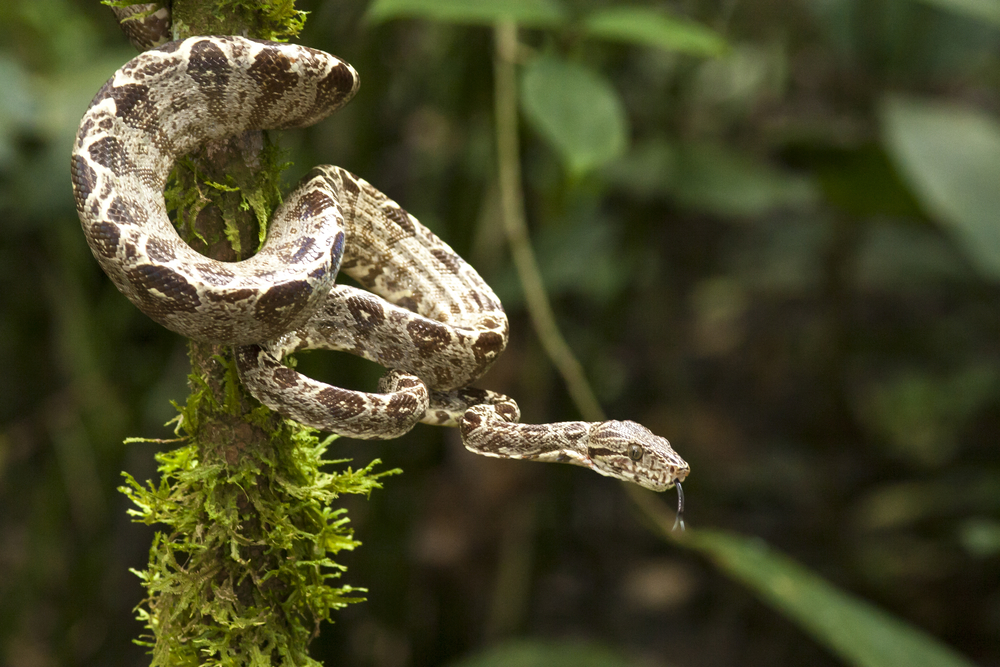The Amazon or ‘garden’ tree boa (Corallus hortulana) is a widespread species of arboreal constrictor found throughout tropical South America. Growing to around 6ft in length, these slender boas are adept at climbing narrow branches and occupy a range of habitats from tropical primary forests to human-altered gardens and the outskirts of agricultural areas, providing they have a robust canopy to inhabit. Like their cousins, the emerald tree boas (C. caninus & C. batesii) young Amazon tree boas are brightly coloured and striking to behold. Unlike their green compatriots, the Amazon tree boa does not go through a major ontogenetic change as it ages, producing perhaps one of the most variable snake species on Earth. One person who has had the joy of witnessing this development first-hand is Ben Bailey, who has bred Amazon tree boas for several years. We caught up with Ben to discuss his fascination with the species…

Amazon tree boas in the hobby
“One of the main draws to ‘Amazons’ for me was the pure variability of them,” said Ben. “There are many different phases and so much variation in their colouration. From the blacks, browns, silvers and greys of the ‘Halloween’ or ‘Garden’ phases to the reds, yellows and oranges of the ‘Colour’ phases, these animals are extremely diverse. They also all have varying amounts of patterning or even no pattern at all.”
Whilst different populations may see higher densities of a certain ‘morph’, the colours and patterns of the Amazon tree boa are not strictly dictated by localities. They are, therefore, “polychromatic’. However, there are some locations where particularly stunning animals are abundant, such as the bright red individuals found in southern Suriname, or the almost uniform yellow morphs of southeastern Ecuador. Whilst many hobbyists will dub their animals with a fancy title such as “Red Hot” or “Tiger”, in reality, these are not true morphs and establishing a dedicated breeding project to produce animals of a certain appearance is unlikely to prove successful. Instead, most breeders are simply fascinated by the natural history of the species.
Ben continued: “The Amazon tree boa was the first species of snake I ever bred. I’m glad they were, as it’s pushed me to appreciate them even more and hopefully I can share with others how amazing this species is and get more people to see the good side of them rather than the reputation they are often tarred with.”
Despite exhibiting many of the favourable traits found in emerald tree boas, as well as being more variable in colouration and more manageable in size, Amazon tree boas are not as frequently kept as one may think. Having previously been imported from the Guiana Shield, these sleight-bodied snakes gained a reputation for being fragile and aggressive. However, now they are more frequently captive-bred, it appears their reputation may be somewhat unwarranted.
Ben continued: “People say adult Amazon tree boas have a ‘bitey’ or aggressive temperament. I find quite the opposite and I know other people who keep a few amazons will generally agree. From the get-go when I got my pair they were very docile and will happily, to this day, let me reach into the enclosure and pick them up or work around them in the enclosure (water changes or cleaning etc.) without batting an eye.”
“Each animal will be different and have different personalities. I do have one Amazon that I got in the last year that precedes its reputation but with time and work, I have no doubt it’ll calm down and become more like my main pair. However, the neonate Amazon tree boas are defensive as soon as they are born, although this is much the same for all neonate/hatchling snakes as they have so many predators when they are smaller. This defensive nature only aids in getting them on to food, which is always handy!”
Amazon tree boa Husbandry
The Amazon tree boa are most frequently found in vegetation and trees around 5 – 15m above the ground, particularly close to streams. They are very three-dimensional in their wild behaviours, adopting a primarily ‘ambush’ hunting technique, although they will sometimes actively scavenge for food. This means they will occasionally visit the forest floor and unlike other members of the genus, will utilise low-lying dense vegetation as shelter during the day. Interestingly, Ribeiro-Junior et al even recorded a Brazilian specimen basking in the sun at 2 pm and there have been multiple reports of feeding behaviours in the morning. It is, therefore, extremely important that the keeper creates a versatile environment for their Amazon tree boa.

“I keep my adults housed separately in 2 X 2 X 3ft PVC enclosures,” said Ben. “PVC enclosures allow for the snakes’ higher humidity requirements, so I can spray them without worry of damaging them. Inside the enclosure, I use branches of varying widths and sizes that are taken from fallen ash trees off our family farm. These are zigzagged from the bottom to the top of the enclosure utilising as much area as possible and crossing over at many points. These are the preferred basking/resting areas for the snakes. Unlike emerald tree boas or green tree pythons, Amazon tree boas prefer multiple branches beneath them, even if they only use one to perch on.”
Ben creates a “naturalistic” aesthetic for his enclosures, by creating hides from cork rounds and using a soil/coconut chip substrate interspersed with real plants. He uses heat panels to create a downward heat gradient from 30℃ at the top, to 23℃ at the bottom. These are tweaked slightly during the breeding season. Humidity is always maintained above 60%. The enclosures are heavily sprayed 3 times a week to provide spikes of +80% humidity.
“I am currently using a 7% UVB T5 bulb which lights up the enclosure fairly well and is used by the animals as they will frequently choose to bask under the UV,” said Ben. “The lights are set at the very front of the enclosures so that they don’t always have to be directly under the light, but they can easily get to a branch to utilize it if they wish. At its closest, the UVB is about 25cm from the branch aiming for a UVI of around 0.80 at its maximum.”
Currently, Corallus hortulana is listed as “Least Concern” by the IUCN, due to its enormous range (an expected 207,837km2!), its abundance on a local scale and the fact that it occurs in many protected areas. However, the species is listed under CITES Appendix 2, meaning there are restrictions on its trade. With fewer and fewer imports arriving from South America, the continuation of Amazon tree boas in captive collections requires more captive breeding projects to become established.
The breeding process
Boas are typically viviparous, meaning they give birth to live young. Across the Amazon tree boas’ widespread range, different populations will breed at slightly different times of the year. Mating generally coincides with the very end of the wet season, so that the young are born at the start of the following wet season (around 6 months later). However, breeders working with this species in captivity must plan much further ahead.
Ben continued: “As the breeding season approaches, which for me is any time around the end of January, I start to put into action my breeding plans. Of course, you want to make sure you have a pair of animals, that they are of good condition and the right age (generally anything over 3 years old, although I would opt for 4 years old for females, personally).”
“Around this time, I will stop feeding and drop temps from the usual 29-30°C highs to 26-27°C highs for around 4-6 weeks. This is not a huge difference in temps and still enough heat to digest any meals within them. The light cycle remains the same (12 hrs on/ 12 hrs off) although I have windows in the reptile room, so this does create a difference of light level in the room itself overall.”
“After 4-6 weeks (mid-February) I will return the heat to normal and begin feeding slightly more frequently than usual (around once a week) along with more frequent spraying of the enclosure.”
“From the beginning of March, I will begin to pair up the male and female by moving the male into the female’s enclosure. For the first couple of weeks, there isn’t normally much happening, but as we get into the beginning of April the locks start to occur and more interest is shown between the pair. At this time, I’m still feeding and spraying heavier than normal, and the pair is separated on and off for feeding. The male will often go off feed at this point for the remainder of the breeding cycle.”
“The locks continue throughout April and into the beginning of May. At this point, I start to see a pre-ovulation swell which is soon followed by an ovulation. Both times I’ve bred this species now, the ovulation and succession of events after the ovulation have all occurred within a similar timeframe as the previous year. Ovulation is a very noticeable swelling of the lower 3rd of the body and is easily visible. This is followed by a POS (post-ovulation shed) exactly 17 days later. I always find the female to go off food around this time, so this is another helpful marker of success.”
“Alert keepers should notice that this shed is a POS, even if they don’t observe the ovulation. It is this date that I find most important to follow from. The female will not shed again until after giving birth.”
“Once the female has had her POS, the male is removed, and his job is done. From this point, I raise the temperature to highs of 32-33°C as it’s now when the female will begin to hog the heat. She does this to incubate her eggs within her body, like most boas. After the POS, I continue feeding but with smaller meals than normal.”
“It can take anywhere from 110-160 days after the shed (with an average around 120-130) before she gives birth. In my case, it’s been exactly 126 days each time. Throughout this time, the female will begin to get larger and larger and her scales will very noticeably separate along with her colours getting very dark for the duration of the gestation.”
“I find the female stops feeding around a month before giving birth and finally after 4 months of waiting you will get the last sign that she is close. Around 24-72 hours before giving birth she will have a very waxy-looking poo and after not feeding for a while this will be the first poo in weeks so you will know it’s nearly time. After the waxy poo, I will remove the water bowl at night just so there are no hazards if they are born at night.”
“One day you will be greeted with a smell that you will only know if you’ve had a boa give birth. You walk up to the enclosure and see lots of little angry multicoloured neonate amazon tree boas hanging from all the branches and it’s just a sight to behold, there is nothing like it. Such excitement and relief after a long 4-month wait.”
Rearing neonates
Amazon tree boa litters can range in size from two to 29 neonates. In the wild, the young snakes will quickly disperse as mothers have been reported to eat their young. Luckily, these young snakes are miniature replicas of the adults in all but colour/pattern and will soon become self-sufficient.
In captivity, it is important to house neonate Amazon tree boas in individual enclosures as quickly as possible. For this, Ben uses 3L Braplast Tubs to prevent any potential escapes or damage. “My top tip is no matter how small a hole or gap is in the viv either remove the item or close off the gap!” explains Ben. “I used to keep heat cages over the heat panels to stop the adults from getting too close, one morning, one of the neonates had already managed to climb through the tiny holes in this and couldn’t get out. By the time I came into the room, it had perished.”
Once Ben has moved the newly born Amazon tree boas into their enclosures, he provides them with a small cup of water and paper towels as substrate. Whilst this may not be the most aesthetically pleasing method, it does allow easy observation of the animals and their stools, so the keeper can asses their health at a glance.
“Once separated, I add plastic deer fencing (most plastic garden-type fencing works) that is placed from one edge to the other creating a big curve and allowing different heights. The fencing works brilliantly as the neonate Amazon tree boas can sit on many different support points while still being perched. It’s easy to clean if needed and you can take out the piece of fencing with the snake on without disturbing them too much.”
The neonate Amazon tree boas are kept at the same environmental parameters as the adults. However, Ben chooses to air on the cooler side if necessary, never exceeding 30℃ within the tubs. “Neonates will shed around 2 weeks after being born and from this point, I will start to offer food. I use defrosted pinkies and I haven’t had any trouble yet.”
“So far, I’ve only had small litters from my Amazon tree boas” added Ben. “The first had four healthy young; two were a light orange, one was ‘Garden’ phase and one was a deep red colour. My second litter contained six healthy neonates all of various shades of orange, except one ‘Garden’ phase. Both parents I would say, are orange colour phase with heavy pattern almost 50% orange colour and 50% grey pattern over the top and it seems all the neos will follow suit over time apart from the two garden phases.”
“It seems they have produced more of their own phenotype so far, but I still get the ‘Garden’ phase in smaller quantities. From my experience with the first litter, the neonates will gain pattern as they age and colours will get more extreme. Amazon tree boas change considerably in their own way over time, this is one of the main reasons why I love this species so much!”
